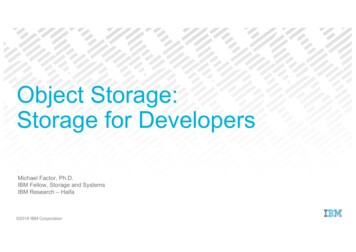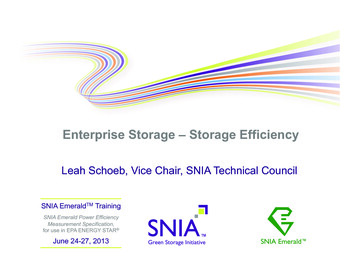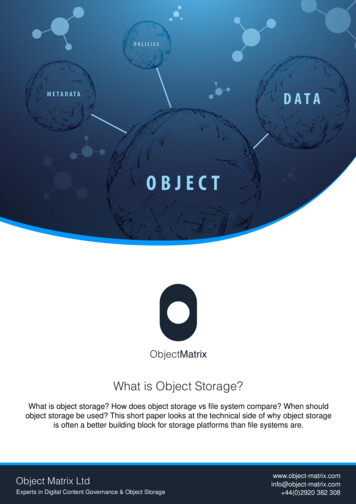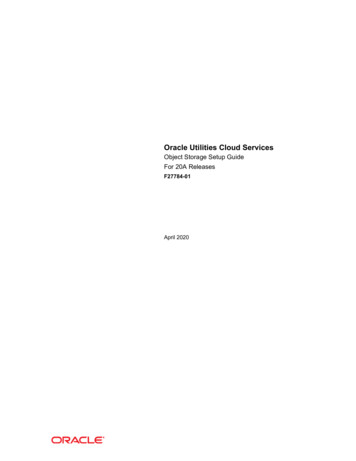
Transcription
Object Storage:Storage for DevelopersMichael Factor, Ph.D.IBM Fellow, Storage and SystemsIBM Research – Haifa 2018 IBM Corporation
2018 IBM Corporationsource: nk-2740217/
2018 IBM Corporationsource: ion-296115/ IBM Corporation 4
Need to– Store– Manage– Protect– Securewhile addressing– Scale– Costthe data enabling developers to– Collect– Clean/transform– Analyze 2018 IBM Corporation
How should we do this? 2018 IBM Corporation
And the answer is . . . 2018 IBM Corporation
. . . Object Storage 2018 IBM Corporation
What is object storage?Block, File and ObjectTypical object storage features§ Block: An array of bytes§ Buckets containing keys for objects– Hierarchy is in eyes of beholder§ File: Explicitly managed hierarchy ofrandomly accessed blobs§ Object: Key-value (object)§ RESTful (HTTP) access§ All or nothing atomic writes – no updatein place§ Data with metadata§ Secure in flight and at rest§ Designed for scale out and durability§ Ideal for unstructured data and batchrectangular data 2018 IBM Corporation
Designed for developers Simple, RESTful API Atomic operations Globally accessible “Limitless” 2018 IBM ssman-laptop-1459246/
How the APIs varyBlockFileObject§ READ§ OPEN§ PUT§ WRITE§ CLOSE§ GET§ FORMAT§ RENAME§ HEAD§ .§ WRITE§ POST§ .http://t10.org/ftp/t10/document.05/05-344r0.pdf 2018 IBM Corporationfd open(”tmp.tmp”, O WRONLY);for(i 0;i LIMIT;i )write(fd,buffer[i*WRITE SZ],WRITE SZ);close(fd)rename(”tmp.tmp”, “real.name”)PUT /bucket/object HTTP/1.1Authorization: {auth}Content-MD5: 3097216.Host: storage.softlayer Content-Length: 533The 'queen' bee . . .
Under the covers of one objectstore: IBM Cloud Object Storage 2018 IBM Corporation
IBM Cloud Object Storage§ Two tiered, fully distributed, architecture– Can be deployed in multiple data centers – survive a data center outage§ Distributed erasure coding to protect the data§ RESTful protocol for data access (S3-compatible)§ Security via AONT-RS (All Or Nothing Transform-Reed Solomon) 2018 IBM Corporation
1DATA SOURCESData isencrypted, and slicedusing InformationDispersal Algorithms(IDA).ACCESSER LAYER1234123412342159261037114812Slices are dispersedto separate disks,storage nodesand/or geographiclocations.SLICESTOR LAYER123456789101112IDA WIDTH 12 Total number of slices created 2018 IBM Corporation IBM Corporation 14
§ With a 7 5 RS encoding, can read data from any 7 slices§ If distributed over three data centers, can lose an entire data center with no loss of data or access§ Space overhead of 71% as compared to 200% with triplication159261037114812SLICESTOR LAYER123456789101112IDA WIDTH 12 Total number of slices created 2018 IBM CorporationPutting to work
AONT-RS: Keyless EncryptionAll Or Nothing Transform – ChecksumdifferenceRandom KeyXORHash orage-systems 2018 IBM Corporation
AONT-RS: Keyless EncryptionAll Or Nothing Transform – Reed-SolomonEncryptedDatadifference§ Without a threshold number of slices, cannot calculate hash and thus cannot separate keyout of difference which is XOR of key and rage-systems 2018 IBM Corporation
Putting data to work 2018 IBM Corporation
Need to– Store– Manage– Protect– Securewhile addressing– Scale– Costthe data enabling developers to– Collect– Clean/transform– Analyze 2018 IBM Corporation
Sales Data AnalyticsCOLLECTEmploy Stocator: a highperformance, reliableSpark connectorIBM CloudObject StorageCLEAN/TRANSFORMApache KafkaSales recordssent to objectstore over Kafka 2018 IBM CorporationSales records batched andpersisted in object storage,e.g., via Kafka Connect orSecorUse Spark toaggregate datato enable BIqueries
Sales Data AnalyticsThrough notebook, dataanalyst at retailer decides onsales promotions using Sparkto analyze data and visualizeresultsEmploy Stocator: a highperformance, reliableSpark connectorIBM CloudObject StorageANALYZEApache KafkaDataAnalyst 2018 IBM ss-computer-female-15704/JupyterNotebook
A right way and a wrong way to use object storageWrong WayPretend it is a file systemEmulate design patterns such as write totemp file and rename to prevent partial dataCreate empty objects to representdirectories 2018 IBM CorporationRight WayLeverage object storage semantics andscaleUse atomicity of PUTs to prevent partial dataJust create objects with hierarchical sign-road-caution-167535/
Stocator: Enabling Apache Spark forIBM Cloud Object Storage§ Historically community treated objects stores asfile systems– Leads to inefficiencies and races e.g., multiple non-atomic operations where asingle operation would suffice§ Stocator is our opinionated alternative– Knows it is talking to an object store Uses atomic PUTs and not renames No dummy objects for directories .– Both fast and correct§ Stocator is in open source– https://github.com/SparkTC/stocator 2018 IBM CorporationHadoop Filesystem InterfaceStocator
torHadoop SwiftS3aRESTful operationsSecondsStocator is much faster for write-intensive workloads; has equivalent performance forread workloads; and issues many fewer REST (5TedodaaWReReHadoop SwiftS3aAs compared with the object storage connectors of Hadoop 2.7.3 run with their default parameters with Spark 2.0.1See https://arxiv.org/abs/1709.01812 2018 IBM Corporation
Need to– Store– Manage– Protect– Securewhile addressing– Scale– Costthe data enabling developers to– Collect– Clean/transform– Analyze 2018 IBM Corporation
THANK YOU 2018 IBM Corporation
Notices and DisclaimersCopyright 20168by International Business Machines Corporation (IBM). No part of this document may be reproduced or transmitted in any form without written permissionfrom IBM.U.S. Government Users Restricted Rights - Use, duplication or disclosure restricted by GSA ADP Schedule Contract with IBM.Information in these presentations (including information relating to products that have not yet been announced by IBM) has been reviewed for accuracy as of the date ofinitial publication and could include unintentional technical or typographical errors. IBM shall have no responsibility to update this information. THIS DOCUMENT ISDISTRIBUTED "AS IS" WITHOUT ANY WARRANTY, EITHER EXPRESS OR IMPLIED. IN NO EVENT SHALL IBM BE LIABLE FOR ANY DAMAGE ARISING FROM THEUSE OF THIS INFORMATION, INCLUDING BUT NOT LIMITED TO, LOSS OF DATA, BUSINESS INTERRUPTION, LOSS OF PROFIT OR LOSS OF OPPORTUNITY.IBM products and services are warranted according to the terms and conditions of the agreements under which they are provided.Any statements regarding IBM's future direction, intent or product plans are subject to change or withdrawal without notice.Performance data contained herein was generally obtained in a controlled, isolated environments. Customer examples are presented as illustrations of how those customershave used IBM products and the results they may have achieved. Actual performance, cost, savings or other results in other operating environments may vary.References in this document to IBM products, programs, or services does not imply that IBM intends to make such products, programs or services available in all countries inwhich IBM operates or does business.It is the customer s responsibility to insure its own compliance with legal requirements and to obtain advice of competent legal counsel as to the identification andinterpretation of any relevant laws and regulatory requirements that may affect the customer s business and any actions the customer may need to take to comply with suchlaws. IBM does not provide legal advice or represent or warrant that its services or products will ensure that the customer is in compliance with any law 2018 IBM Corporation
Notices and Disclaimers Con’t.Information concerning non-IBM products was obtained from the suppliers of those products, their published announcements or other publicly available sources. IBM has nottested those products in connection with this publication and cannot confirm the accuracy of performance, compatibility or any other claims related to non-IBM products.Questions on the capabilities of non-IBM products should be addressed to the suppliers of those products. IBM does not warrant the quality of any third-party products, or theability of any such third-party products to interoperate with IBM s products. IBM EXPRESSLY DISCLAIMS ALL WARRANTIES, EXPRESSED OR IMPLIED, INCLUDING BUTNOT LIMITED TO, THE IMPLIED WARRANTIES OF MERCHANTABILITY AND FITNESS FOR A PARTICULAR PURPOSE.The provision of the information contained h erein is not intended to, and does not, grant any right or license under any IBM patents, copyrights, trademarks or other intellectualproperty right.IBM, the IBM logo, ibm.com, Aspera , Bluemix, Blueworks Live, CICS, Clearcase, Cognos , DOORS , Emptoris , Enterprise Document Management System , FASP ,FileNet , Global Business Services , Global Technology Services , IBM ExperienceOne , IBM SmartCloud , IBM Social Business , Information on Demand, ILOG,Maximo , MQIntegrator , MQSeries , Netcool , OMEGAMON, OpenPower, PureAnalytics , PureApplication , pureCluster , PureCoverage , PureData ,PureExperience , PureFlex , pureQuery , pureScale , PureSystems , QRadar , Rational , Rhapsody , Smarter Commerce , SoDA, SPSS, Sterling Commerce ,StoredIQ, Tealeaf , Tivoli , Trusteer , Unica , urban{code} , Watson, WebSphere , Worklight , X-Force and System z Z/OS, are trademarks of International BusinessMachines Corporation, registered in many jurisdictions worldwide. Other product and service names might be trademarks of IBM or other companies. A current list of IBMtrademarks is available on the Web at "Copyright and trademark information" at: www.ibm.com/legal/copytrade.shtml.Elasticsearch is a trademark of Elasticsearch BV, registered in the U.S. and in other countriesDocker and the Docker logo are trademarks or registered trademarks of Docker, Inc. in the United States and/or other countries. Docker, Inc. and other parties may also havetrademark rights in other terms used herein.Apache, Apache Spark, Spark, Apache CouchDB, CouchDB, Apache Hadoop, Hadoop, Apache Parquet, Parquet, Apache Flume, Flume, Apache Mesos, Mesos, ApacheKafka and Kafka are trademarks of the Apache Software FoundationOpenStack and the OpenStack Logo are trademarks of the OpenStack FoundationSome of this work has received funding from the European Union’s Seventh Framework Programme for research, technological development and demonstration under grantagreement no 609043 2018 IBM Corporation
What is object storage? Block, File and Object §Block: An array of bytes §File: Explicitly managed hierarchy of randomly accessed blobs §Object: Key-value (object) Typical object storage features §Buckets containing keys for objects -Hierarchy is ineyes of beholder §RESTful (HTTP) access §All or nothing atomic writes -no update in place §Data with metadata










